Roger J. Wendell
Defending 3.8 Billion Years of Organic EvolutionSM


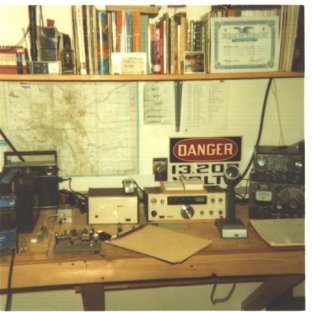
The photo at left is from my 1974 shack when I was a teenager. It includes a Ten Tec Argonaut (model 505), Multi Elmac AF-68, a Vibroplex, a relative signal strength meter (upper left), a large 12 volt car battery, and a bunch of other stuff I'm not able to identify at this time! On my QRP page I have a few photos of small projects I was working on in early 1975...

|
Click Here for the YouTube video of my station! |

|
Click Here for my tribute to Morse telegraphy! |

|
Click Here for my antenna page! |

|
Click Here for my QRP page! |
My Shack:
My current shack, by past standards, is relatively modest although it's regularly changing or being updated. Compared to when I started in amateur radio, the computers, laptops, and smartphone are what's changed the most for me over the years. Except for a linux box (now a Raspberry Pi) the other computing "power" in my shack is out of view in these photos. Despite all of "high tech" upgrades, I don't use the computers for radio control (SDR) as I like to keep things simple and portable with low power QRP gear and basic antennas. Of course my gear and the shack's configuration is always changing but what you see here, in these photos from the 2nd decade of the 2nd millenium, is the general configuration I like to maintain. (general coverage receiver, HF QRP CW, VHF/UHF multimode, etc.)
(Click on any "thumbnail" image for a larger view)
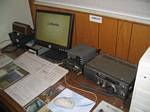 Clean Desk... |
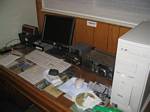 Messy Desk... |
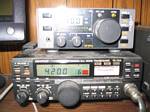 K1 and TR-751A |
 K1 and TR-751A |
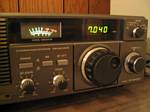 Kenwood R600 |
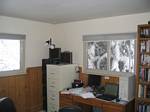 Messy Winter Desk... |
R. A. KentMy keyer of choice remains AEA's MorseMachine - I still have the original one although I understand they may be up to version three by now (mid 2000s)... Anyway, I've always loved clean, crisp code and avoid using straight keys and springloaded devices as a result. For now I'm using an R. A. Kent Iambic paddle that's a very solid, "weighty" device that suits me well. Again, I don't use the computer or any other device for copying code - that's something I still enjoy doing for myself!
My Antenna - Doublet, Zepp, Double Zepp, or Dipole?
As these pictures will illustrate, I occassionally experiment with my antenna by changing its length, feedline, balun, and other parts and hardware. The main theme, for me, is simple wire antennas! Although I've used all kinds of beams, yagis, rhombics (when I was a Coast Guard radioman), dishes and other directional antennas my choice at home is wire. The reason is because wire (until the heafty price increases for copper around 2007 or so) is inexpensive, easy to work with, and doesn't seem to ever bother my neighbors.So, you can see from these photos I've been mostly playing around with dipoles, "Doublets," and "Zepps" (Zepp is short for Zeppelin and is any resonant antenna end-fed by ladder line. A Double Zepp is a center-fed 1/2 wavelength antenna. The double extended Zepp is a dipole type Antenna consisting of two collinear 0.64 wave length elements fed in phase - providing 3 db gain over a dipole on the band it's designed for...)
The wire I've been using, for the "dipole" part of my antenna is 10 gauge stranded copper that's been cut, usually, to around 88 feet (26.8 metres) or sometimes to quarter wave-length (on each side) for the 40 meter band. In the past I fed the antenna with 300 Ohm twin-lead ("ladder line") that was attached to an LDG Electronics 4:1 Balun. The Balun immediately "plugs-in" to the BNC connector on the backside of my K1 transciever via some PL-259/SO-239/BNC connector adapters. Although a balun ("Balun" stands for balanced-unbalanced matching transformer) is easy to build I purchased this one becuase the price was right at the time. However, I'm not sure what improvement it provided as I've made contacts all over the northern hemisphere using just one Watt on 20 and 40 meters CW.
I think the easiest, and most successful antenna for me has been the 88 foot doublet fed with 450 Ohm ladder line strait out of my antenna tuner. That configuration has provided the broadest spectrum of coverage across most of the bands and has been easy to maintain because both the feed line and dipole lend themselves to quick soldering and other repairs. Either way, I'll continue to experiment with various wire combinations as I live on a very steep residential lot with a couple hundred metres of Conglomerate (rock consisting of individual clasts within a finer-grained matrix that have become cemented together...) blocking my view of the horizon in a couple of directions...
450 Ohm Ladder Line from early 2008 to present: (interrupted during the summer of 2011 for a roof replacement!)
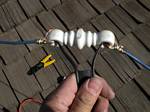 Construction |
 Ceramic insulator |
 Dipole |
 Doublet |
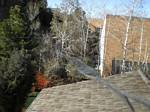 Twisting in the wind... |
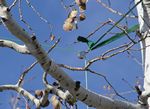 End-pulley |
300 Ohm "twin-lead" from about 2002 through early 2008:
 Wooden insulator! |
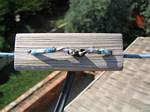 Close-up |
 Dipole |
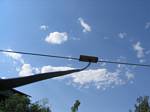 Looking up the Ladder Line |
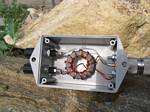 4:1 voltage Balun |
 Balun Toroid |
Dipole Discussion:
As you can see, a dipole is about the most difficult antenna to photograph because it's long, thin, and hard to see! The good news, as you can see from the above photos, is that dipoles are easy to make, install, and maintain. I've even used versions of this one to make contacts all over the hemisphere with and without the balun using just one Watt of output power! I also saved some time and money by making the connection between the twin-lead and dipole out of a piece of wood at one time! Other hams sometimes place the balun right at that central point (feeding it with coax) while other's use a "Ladder Grabber" or plastic pieces to join feed line and antenna. My "center piece" of choice (so to speak!) is a ceramic insulator but they're getting harder and harder to find if you happen to break one (or two or three...) All in all, the dipole/Doublet/Zepp works well, is inexpensive, easy to install, and a good choice in neighborhoods with antenna restrictions! - WBØJNR

|
Click Here for my antenna page! |

Previous Shack(s):
Here are some pix from my station when we
lived near Cherry Creek Reservoir, southeast
of Denver, from 1980 to 2002:
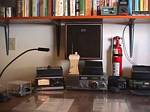
In the middle is a Kenwood R-600 general coverage receiver (This was Kenwood's first digital model). The Wooden Radio sitting on top of it is something I "won" in 1999. The Colorado QRP Club awards the Wooden Radio to members who have experienced something humerous as it relates to radio... Next to the wooden radio award is an AEA Morse Machine 3 sitting on the rotor control for my 15 element two meter beam. Everything you see in these photos was powered by solar (We're using Xcel Energy's WindSource until I can get the panels back up at the new house...).
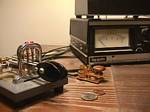
The Vibroplex (SN 68256) "drives" my solar powered AEA MorseMachine 3 electronic keyer. I enjoy the Vibroplex immensely but kept losing contact continuity over extended periods of use. Taking the contact points in to a jewler for gold plating seems to have solved the problem! The Morse Express 2001 "Christmas" key (SN 003) is a completely functional (and comfortable!) miniature hand key that offers all the adjustments and stability of larger models. Designed by N1FN, only 200 of these keys were manufactured, by hand, in Europe by Llaves Telegraficas Artesanas.

This is the right side of my shack. That's a Kenwood TR-751A all mode two meter transciever (I've worked about 30 states on CW through Tropo, Meteors and E openings). Further to the right is an ICOM 735 ("Cranked Down" to 3 watts output), and an Oak Hills Research WM-1 wattmeter (It's half hidden but has a knob sticking out next to the base of my Low Pass Filter) and an American Optics microscope. Farthest right is an MFJ-941E Tunner for the 300 ohm ladder line that feeds the Zepp.
Coast Guard Portable
Age 20, Hawai'i, 1976While I was in the Coast Guard I had plenty of access to Club Stations like KH6UL (O'ahu) and W6ZZM (Petaluma). However, like everyone else, I always loved having access to my own gear - even in the barracks as suggested by this photo from NMO. I believe that Tempo FMP was my first two meter rig. The antenna was a "homebrew" quarter-wave vertical with my own idea for a ground plane (it can be seen above my head if you look carefully). I used the TenTec KR50 for Ham Radio purposes but never on the job at NMO. Why? Even though I was the Coast Guard's fastest CW (Morse code) operator I was protesting the use of Vibroplex-type "bugs" throughout the service. So, since I refused to use or be tested with a "bug" (very few operators, if any, could send decent code with 'em anyway) I wasn't allowed to use a keyer (which made absolutely no sense at all but, hey, this was the government we're talking about - bureaucracies are the same the world over!)! So, this little incident proves I've always been a curmudgeon - even as a teenager!


|
Click Here for QRP and amateur radio! |

|
Click Here for the International Morse code alphabet and phonetics |

|
Click Here Wooden QSL cards! |

Gear I used to own:

At that same Jeffco Hamfest (above) I also parted with, sadly, three sections of Rohn 25g tower. I used that tower for almost 14 years at my southeast Aurora (Cherry Creek Reservoir) QTH but couldn't "swing" a beam around at our new house on Green Mountain. The three sections of tower (one was the "topper"), rotor mounting plate, and house mounting bracket went to Vince and another guy up in Berthod in a complex sale that totaled $100 (The complexity was from a variety of offers, most of which didn't want all five pieces). Not bad considering there was so much tower hardware on the market at that time!!

Links:
|
|

 Back to Roger J. Wendell's Home Page...
Back to Roger J. Wendell's Home Page...
Abbey |
About |
Blog |
Contacting
Me |
Copyright |
Disclaimer |
Donate |
Guest
Book |
Home |
Links |
Site
Index |
Solutions |
Terms,
Conditions
and
Fair
Use |
What's
Changed
or
New?
Copyright
© 1955 - 2025 Roger J. Wendell. All Rights Reserved.